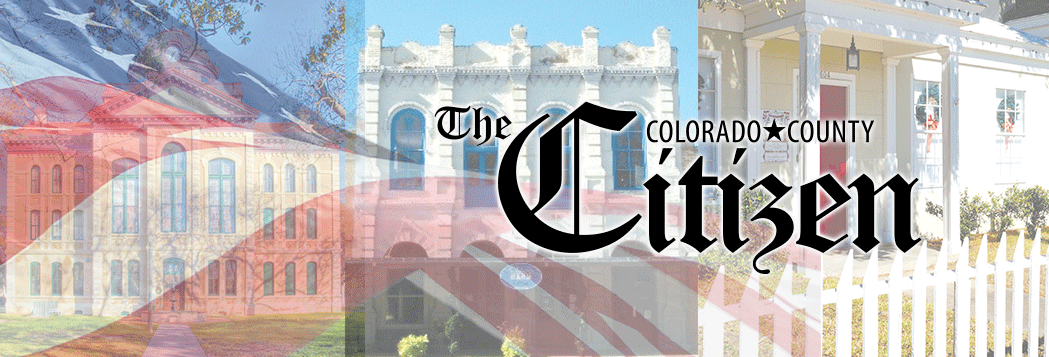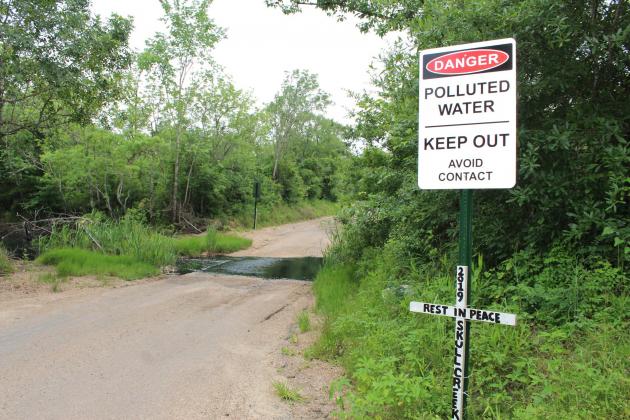RRC records allege Inland discharged directly in to Skull Creek
Docs show washout operations were a concern going back to June ’18
Citizen | Vince Leibowitz

Editor’s Note: This story is the first in an ongoing series examining records obtained by the newspaper from state agencies relating to ongoing contamination at Skull Creek near Altair.
Officials with Inland Environmental & Remediation allegedly admitted to discharging purportedly treated wastewater from its container washout operations directly in to Skull Creek just days before the first incident of contamination was reported at the creek, according to public records reviewed by The Colorado County Citizen.
The records, obtained by the newspaper from the Texas Railroad Commission under the Texas Public Information Act, bring in to focus Inland’s container washout operations, which have become central to the state’s lawsuit against the company relating to contamination at Skull Creek.
The records further show that commission officials were concerned about the waste from the washout operations as early as June, 2018, and shed light on other of the company’s former operations.
The records also reveal a Texas Railroad Commission official, and not a private citizen, was likely the person responsible for the first complaint to the Texas Commission on Environmental Quality (TCEQ) concerning potentially unpermitted activity at Inland, made two days before the first incident of contamination was reported at the creek.
Washout concerns
As early as June, 2018 Texas Railroad Commission officials were raising concerns about the washout of chemical totes at Inland.
“This activity is not under RRC jurisdiction and the wash rinsate water cannot go down the injection well,” indicates an internal agency inspection request dated June 4, 2018.
The inspection request went on to instruct an unidentified site inspector to seal the disposal well, determine if Inland was injecting in to the well, and, if so, what they were injecting, and to issue a violation.
“If they are not injecting, determine where they are disposing of the rinsate water,” the inspection request instructs the inspector.
The investigator was instructed to ask for manifests and run tickets for the rinsate water.
“If necessary, contact the local TCEQ Region 12 office,” and “arrange for a joint inspection,” the inspection request continued.
When commission conducted an onsite inspection two days later, the report of the inspection indicates Inland’s site foreman “stated that water is injected into the well on occasion,” and “rinsate water from the wash rack where the chemical totes are washed is not being hauled off site. Received call from owner David Polstin [sic] during inspection. Mr. Polstin stated the wash water is being recycled on site.”
2019
On Jan. 30, of this year, Railroad Commission officials were again raising alarms about Inland’s container washout activities, ultimately questioning whether Inland’s activities were in compliance with TCEQ permits.
That day, Dean Southward, a RRC staffer for site remediation in the agency’s oil and gas division, wrote to Peter Pope, Manager of Site Remediation for the RRC’s Oil and Gas Division, that he was “familiar enough with the site to point out the location of buried waste,” and other locations an outside remediation contractor may want to investigate.”
Pope replied asking Southward if there, “is an area off to the left that is used to store chemical totes...many totes...perhaps to be cleaned?”
Pope asked him to take pictures of the totes--wide shots and closeups.
‘Who knows’
On Feb. 4, Peter Fisher, District 3 Director of the Railroad Commission’s Houston office, asked Allen Sfcik, a field inspector for the commission, to let him and half a dozen other commission employees copied on an email “know if any trucks are washing out,” and, “If so, take pictures, get plate numbers, and any other necessary information.”
Fisher went on to write in the same email that Boundary Ventures, a company controlled by David L. Polston, which owns the injection well on Inland’s property, “does not have an active P-5 permit (STF-010) to receive such waste.” The RRC sealed Inland’s disposal well for failure to report disposal well volumes, as required by its permit in 2016.
The next day, Feb. 5, Sefcik responded that he had seen “vacuum trucks and frac tanks washing out on the wash rack from time to time.”
“I was told by David Pol-stein [sic] himself that that was all waste water coming for plants and not oilfield locations,” Sefcik wrote.
He ended his email to Fisher noting, “who knows if he is telling the truth.”
Pumped in the creek
Fisher then replied back telling Sefcik, “I have one question,” asking him, “where does the rinse water from the washout pit go after the washout pit fills up? See if Polston can provide you documentation of where the rinse water goes.”
A little more than an hour later, Sefcik replied, “David [Polston] told me for us to look on the TCEQ website for his permit and it will tell us what he does with it.”
Fisher asked Sefcik in another email why Polston couldn’t tell Sefcik directly.
Ten minutes later, Sefcik replied that Polston, “told me the water is treated to meet TCEQ specs according to his permit then it is pumped into Skull Creek.”
In June, 2018, Polston told RRC officials the rinsate was recycled on site.
According to the lawsuit filed against Inland by the Texas Attorney General’s office last month, the washout operation washes “truck tires, plastic totes,and other storage materials that have come in contact with waste.”
The lawsuit further goes on to state, Inland is”not permitted to discharge process wastewater or storm water associated with industrial activities that has commingled with process wastewaters, or industrial solid waste in to or adjacent to any water in the state.”
TCEQ complaint
On the morning of Feb. 6, Fisher replied to Sefcik and others that he had, “filed a complaint with TCEQ Region 12 to investigate Mr. Polston’s claim that they had permit(s) to treat and discharge water into Skull Creek.”
He went on to write that he “gave them information regarding their business of receiving and rinsing out chemical totes and vacuum trucks.”
Inland operations
Other records released by the RRC shed more light on Inland’s former operations, before the commission sealed its injection well.
A report dated Jan. 17 from Terracon, a private company hired by the RRC to conduct remediation activities at Inland’s Boundary Ventures site, notes that “the site has been the subject of RRC enforcement for many years and has failed to properly reduce its inventory of oil field waste (mainly impacted drill cuttings), finished recycled product, or to properly address environmental concerns.”
The report goes on to state, “the facility was authorized to receive, store, handle, treat, and dispose of certain nonhazardous oil and gas waste,” and, “authorized to landfarm water-based drilling mud and cuttings and allowed to manufacture road base from cuttings.”
Background
The commission revoked Boundary Ventures’ permit to permit to operate as an oilfield stationary waste treatment facility in April 2017.
Ramona Nye, spokesperson for the Commission, said in early March that the revocation came after the company announced it would file for bankruptcy, and had failed to comply with the conditions of a 2012 settlement order.
As a result of the settlement, the commission collected Boundary Venture’s $5.7 million financial assurance bond. The company was also fined $500,000.
Boundary Ventures filed for Chapter 11 Bankruptcy Sept. 14, 2016. The case was closed April 11, 2018.

